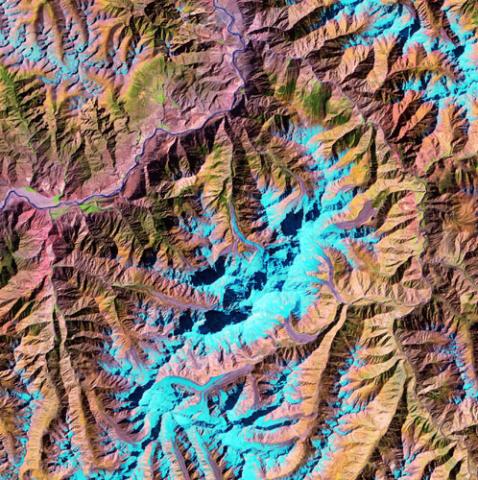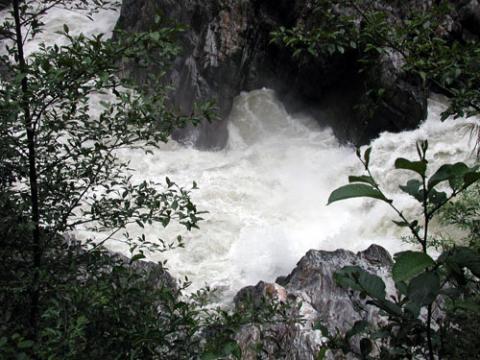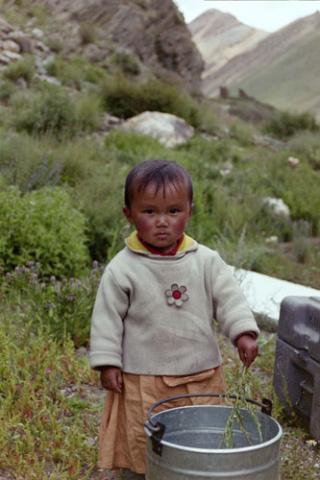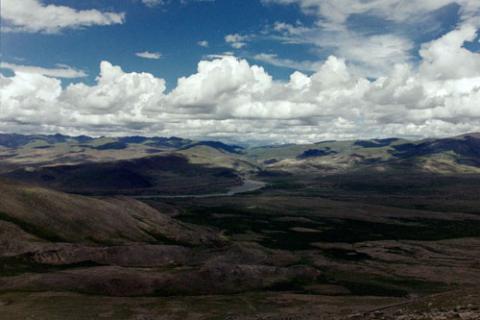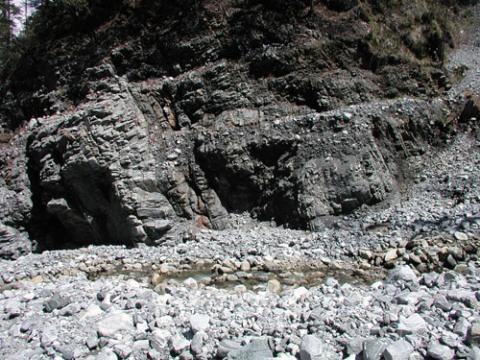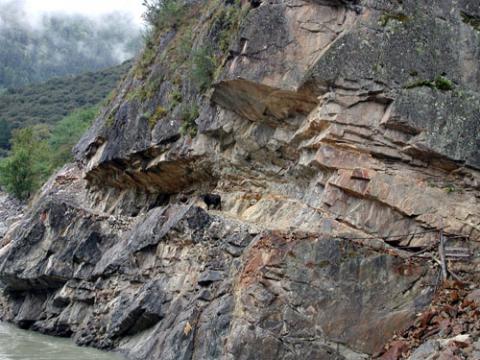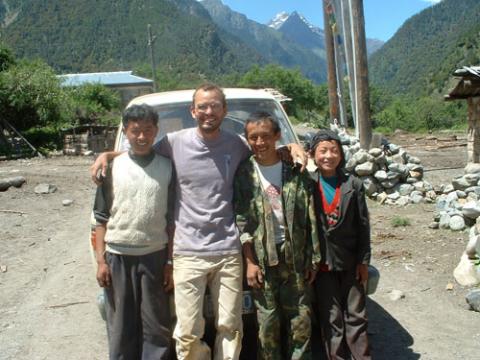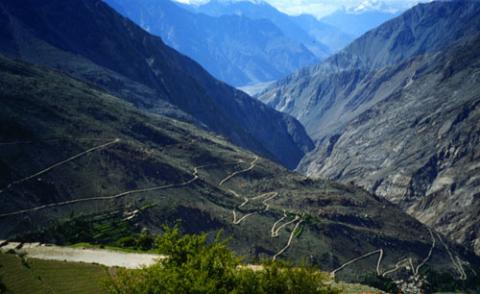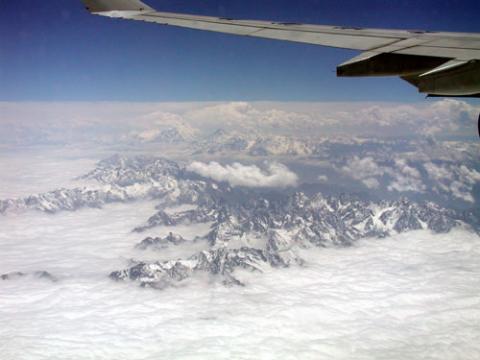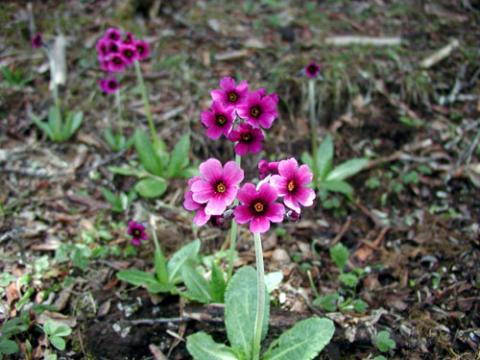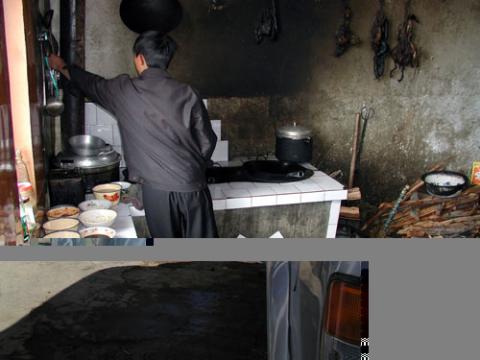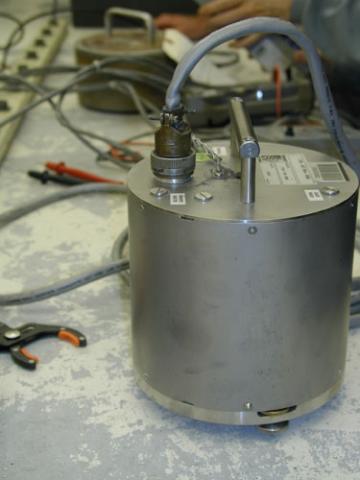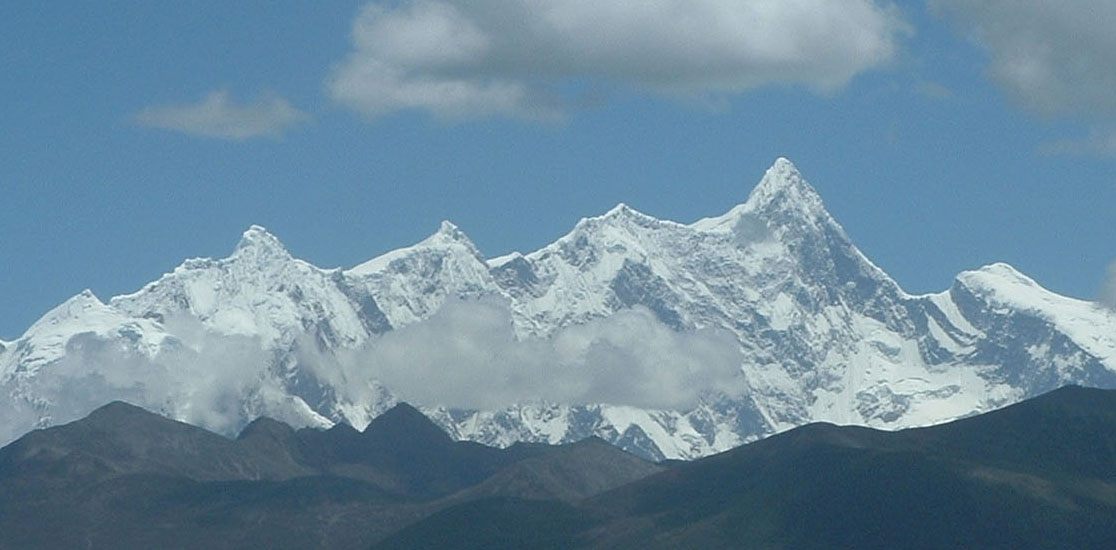
Some of the most dynamic geology on Earth takes place where the Himalayan ranges end in sweeping arcuate bends. These pages describe our research into the origin and dynamics of these regions, in two large projects based in northern Pakistan and most recently in southeastern Tibet.
The Himalaya and Tibet are wonderful natural laboratories for studying mountain building, as their dramatic topography, recently formed rocks, and contemporary geophysical anomalies are all evidence for the tectonic processes that are active here. The Himalaya also provide a great opportunity to explore interactions between tectonic processes in the solid Earth and geomorphic processes on the surface, including the possibilities of feedback from one realm to the other as well as to phenomena like climate and geologic hazards.
We'd like to share our enthusiasm for working in such a spectacular, geologically active part of the world by providing information about this project's origin, science, participants, and results. We hope that students, educators, colleagues, and the citizens who support this work will find something of interest. Start with a look at the project background, or take a look at the gallery above to see what working in Tibet is like.
We'd welcome comments or suggestions. Thanks for visiting!
Compared to the rocks underlying the ocean basins, the continents are complex and their origin remains enigmatic. How the continental lithosphere came to be formed, how continents are assembled, and how they are deformed and reworked are just some of the questions that are currently under investigation by geologists. In the United States, the Continental Dynamics Program of the National Science Foundation provides support for many of these studies, which frequently involve large teams of scientists from around the world.
The Himalaya and Tibet are an excellent place to examine questions about the deformation of crust and mantle lithosphere during continental collision. The Himalayan orogen and the elevated Tibetan Plateau are products of the collision between the Indian and Asian plates, which started some 60 million years ago, and is still continuing. Before collision, Tibet itself was gradually assembled from a series of continental fragments. What makes the Himalaya-Tibet system interesting is that it is young and still active, so that it easier to tease out the role of various mountain-building processes, and in some cases, observe them directly.
In the Himalaya and Tibet, there are a number of issues that have intrigued geologists for over the past decade, and several of these issues are particularly interesting to us. Because they form the intellectual backdrop for our work, it's worth spending a few moments reviewing them.
How strong are the rocks in Tibet?
One striking and engimatic feature of Tibet is the height and overall flatness of the plateau. The crust in Tibet is thick, and it was suggested some time ago that the Tibetan lower crust might be weak, likely to flow ,and therefore not capable of supporting large topography. More recent geodynamic computer models support this notion and do well at predicting some of the features of the Plateau, like its steep but undeformed eastern margin, which seems "inflated" from below and the side. Finally, the INDEPTH project obtained geophysical data that some have interpreted as direct evidence for partially molten and thus weak material in southern Tibet.
What happens at the ends of a mountain belt?
The structures and trends of the Himalaya change sharply at both ends of the range, defining bends called "syntaxes." We see this as the expression of a fundamental geodynamic feature, an "indentor corner," that develops along the edges of two colliding plates near the zone of active collision. It is generally accepted that everywhere along the Himalayan arc the Indian "indentor" collides with Asian continental lithosphere, stacking up and deforming the northern edge of India and, in a manner still under hot debate, elevating the Tibetan Plateau. Further, it is possible that the lower mantle part of the impinging Indian lithosphere detaches from the crustal portion, sinking away and leaving the crustal part behind. However messy as all this sounds, the collision is even more complex at the edges of the Indian plate, where material has the option of not only stacking up, but flowing laterally away to the west and east. This lateral motion is evident in the topographic grain of the mountain belt, in the alignment of rivers in southeast Asia, and in results from studies using the Global Positioning System, which show motion around and away from the eastern syntaxis.
Project progress report.The project's official start date was in September, 2001. Our initial group field trip was scheduled for late September, and was effectively cancelled after the September 11 terrorist attacks. Zeitler and Meltzer did make an initial reconnaissance and sampling trip in October, 2001, and since then all teams have been in the field, in most cases multiple times. Problems with Namche Barwa permissions in 2002, ostensibly due to misbehavior by a foreign research team (not us!), caused some further delay in field work. Anne Meltzer and her group completed a pilot seismic experiment in 2002, and have deployed the full broadband array, currently scheduled for recovery in late 2004. Liu Yuping and colleagues at the Chengdu Institute have completed two of our three GPS campaigns, and work is largely complete on U-Pb, Ar-Ar, and zircon U-Th/He dating in the Bamche Barwa and Gyala Peri massifs.
We have held group meetings timed to coincide with the Fall meeting of the American Geophysical Union, which takes places in San Francisco every December. In 2002, this included a special group workshop hosted at Stanford University by Page Chamberlain. This workshop was attended by Chengdu colleagues Ding Jun (Director of the Chengdu Institute), Liu Yuping, and Zheng Lailin. At the 2004 AGU, groups members presented a total of nine posters and talks.
Groups from Stanford (petrology) and University of Washington (surface processes) spent time in the field in May and June, 2004, in collaboration with geologists from CIGMR (Chengdu Institute). Service runs for the seismic array, staffed by Lehigh and CIGMR geologists, continued during this period as well.
A group from Lehigh and from CIGMR made a quick trip to Tibet in October and November, 2004 to remove the seismic array and arrange for its return to PASSCAL in the USA. As we see the GPS and seismic results come in, the focus of our work is now shifting towards integrating these data with surface-process and geological observations, as well broadening tectonic and thermochronological work to a more regional scale.
On January 6-9, 2005, some twenty project members met at NSF headquarters in Arlington, VA to discuss our results to date and to update our science objectives for the remaining portion of the project.
Project News
January 6-9, 2005. Group meeting at NSF headquarters in Arlington VA!
December, 2004. The seismic experiment's field component is complete, as we successfully extracted the array during a fast trip in October. At the SFO AGIU meeting, a number of people gave interesting project-related posters and talks (Anne, Brian, Amanda, Bernard, Dave M., Noah, Stephane, Dick), and Zeitler gave an uninteresting talk.
June, 2004. Teams from UW and Stanford are in Tibet. Anne is in Ecuador. Zeitler is in Tibet. Molly successfully completed her MS and has started at a real job (congratulations!).
April - May, 2004. The service run went well, and the seismic array is ok, despite the usual oddball events for a few instruments.
Reports About Data
Detrital Fission-Track Data. Bernard arranged for an undergraduate to collect sand samples from the Siang River in India (what they call the Tsang po when it gets down there). Dick Stewart at UW has measured fission-track ages on detrital zircons and finds that 47% of the grains must have been derived from downstream of Pai, where we have another sample for comparison. Combining this with Molly's zircon U-Th/He data, this means that some 50% of the Siang sediment load is derived from within the active NB-GP massif!
Detrital U-Pb Data. Using the laser ablation/ICP-MS system at ANU Peter Z. measured U-Pb provenance ages on zircons from the same samples as just described above. Passage through the massif increases the proportion of pre-Mesozoic grains from 45% to 70%, giving a minimum estimate of 50% for derivation of the Siang load within the massif, closely matching the fission-track results.
SHRIMP Zircon Dates From Gyala Peri. Peter Z. has been and is measuring U-Pb zircon ages on granite and samples collected on the north flank of Gyala Peri. Most samples fall to minimum ages of 4 Ma or less, and a few are clearly only about 1.5 Ma in age. Basement ages determined from zircon cores are are mostly about 500 ma, with a few samples yielding 1600 Ma; this is a little different from NB, where core ages of ~900-1300 Ma are more common.
Proposed Meetings
GROUP MEETING: January 2005. This will be happening shortly; let's see what proposals and ideas emerge from this for future gatherings.
Papers in Progress
To eliminate any chances of overlap, hard feelings, or confusion about publications, please report for listing here any papers you are working on or are planning, who the likely authors will be, and the time frame involved.
NB U-Pb dates. Booth, Chamberlain, Wooden, Kidd, Zeitler. In press, American Journal of Science.
Detrital dates, Tsangpo sediment flux. Stewart, Hallet, Zeitler. In prep. for submission to Science in earliest 2005.
NB thermochronology. Malloy, Zeitler, Idleman, Reiners, Liu. In prep. for submission to G3 or EPSL, earliest 2005.
Research Area:
- Tectonics
- Geodynamics
- Active Tectonics
- Geology of Asia


